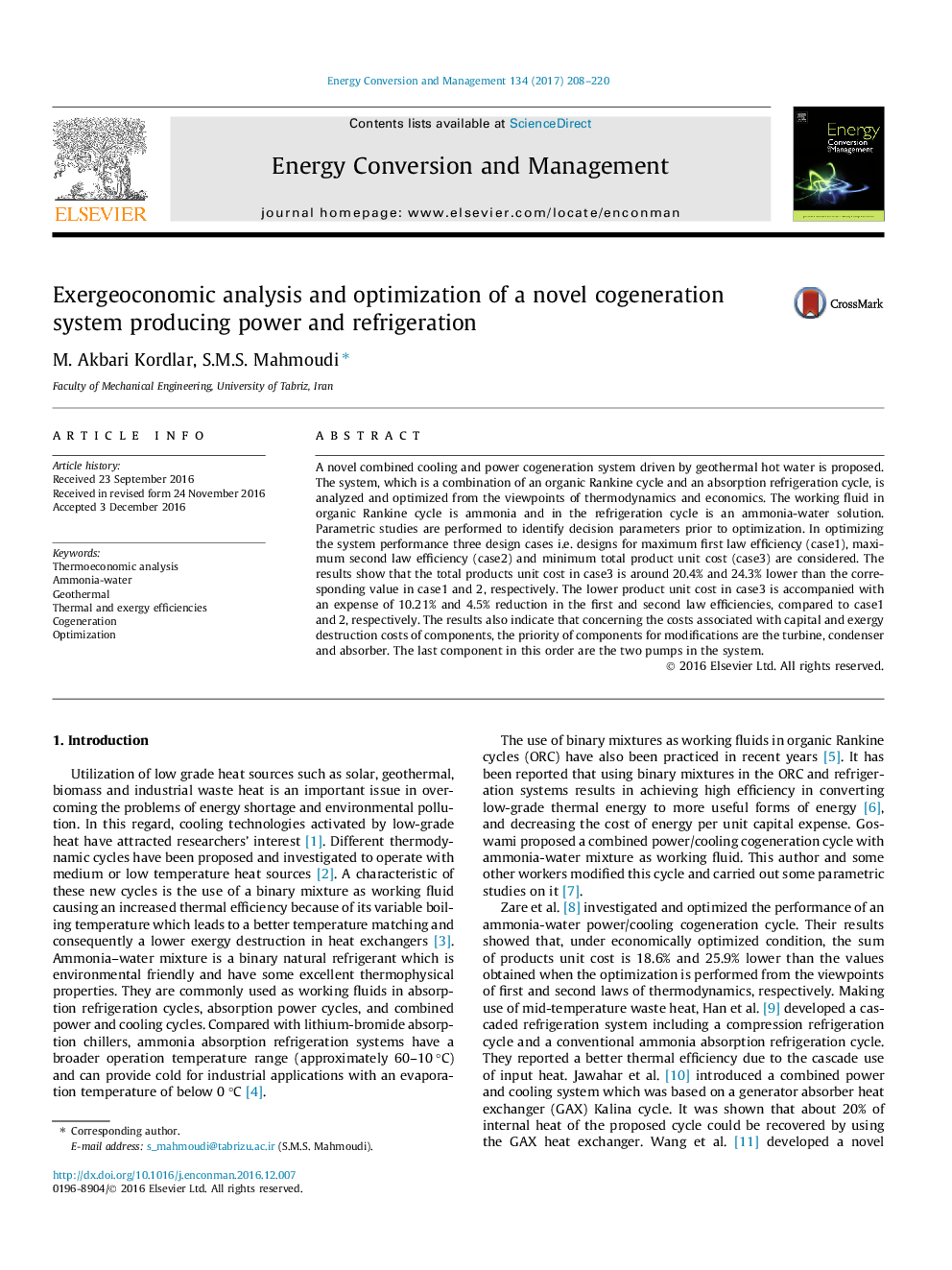| کد مقاله | کد نشریه | سال انتشار | مقاله انگلیسی | نسخه تمام متن |
|---|---|---|---|---|
| 5013057 | 1462828 | 2017 | 13 صفحه PDF | دانلود رایگان |
عنوان انگلیسی مقاله ISI
Exergeoconomic analysis and optimization of a novel cogeneration system producing power and refrigeration
ترجمه فارسی عنوان
تجزیه و تحلیل اقتصادسنجی و بهینه سازی یک سیستم تولید انرژی جدید و تبرید
دانلود مقاله + سفارش ترجمه
دانلود مقاله ISI انگلیسی
رایگان برای ایرانیان
کلمات کلیدی
تجزیه و تحلیل حرارتی، آب آمونیاک، ژئوترمال، راندمان حرارتی و اگزرژی، همگام سازی، بهینه سازی،
ترجمه چکیده
یک سیستم ترکیبی خنک کننده و قدرت کاتیونی جدید که توسط آب داغ زمین گرمایی تهیه شده است پیشنهاد شده است. سیستم، که ترکیبی از یک چرخه رابینین آلی و یک چرخه تبرید جذب است، از دیدگاه ترمودینامیک و اقتصاد تجزیه و تحلیل می شود. سیال کار در چرخه رابینین آلی آمونیاک است و در چرخه یخچال یک محلول آمونیاک-آب است. مطالعات پارامتری برای شناسایی پارامترهای تصمیم گیری قبل از بهینه سازی انجام می شود. در بهینه سازی عملکرد سیستم، سه مورد طراحی برای طرح حداکثر بهره وری قانون اول (مورد 1)، حداکثر کارآیی قانون دوم (مورد 2) و حداقل هزینه کل محصول واحد (مورد 3) در نظر گرفته شده است. نتایج نشان می دهد که کل واحد تولید محصول در مورد 3 در حدود 20.4 و 24.3 درصد کمتر از مقدار مربوطه در مورد 1 و 2 است. واحد تولیدی پایین تر در مورد 3 با هزینه 10.21٪ و 4.5٪ کاهش بهره وری قانون اول و دوم همراه با موارد 1 و 2 همراه است. نتایج همچنین نشان می دهد که در مورد هزینه های مربوط به هزینه های تخریب سرمایه و اجزای اجزای سازنده، اولویت اجزاء برای تغییرات، توربین، کندانسور و جذب می باشد. آخرین مولفه در این نظم دو پمپ در سیستم است.
موضوعات مرتبط
مهندسی و علوم پایه
مهندسی انرژی
انرژی (عمومی)
چکیده انگلیسی
A novel combined cooling and power cogeneration system driven by geothermal hot water is proposed. The system, which is a combination of an organic Rankine cycle and an absorption refrigeration cycle, is analyzed and optimized from the viewpoints of thermodynamics and economics. The working fluid in organic Rankine cycle is ammonia and in the refrigeration cycle is an ammonia-water solution. Parametric studies are performed to identify decision parameters prior to optimization. In optimizing the system performance three design cases i.e. designs for maximum first law efficiency (case1), maximum second law efficiency (case2) and minimum total product unit cost (case3) are considered. The results show that the total products unit cost in case3 is around 20.4% and 24.3% lower than the corresponding value in case1 and 2, respectively. The lower product unit cost in case3 is accompanied with an expense of 10.21% and 4.5% reduction in the first and second law efficiencies, compared to case1 and 2, respectively. The results also indicate that concerning the costs associated with capital and exergy destruction costs of components, the priority of components for modifications are the turbine, condenser and absorber. The last component in this order are the two pumps in the system.
ناشر
Database: Elsevier - ScienceDirect (ساینس دایرکت)
Journal: Energy Conversion and Management - Volume 134, 15 February 2017, Pages 208-220
Journal: Energy Conversion and Management - Volume 134, 15 February 2017, Pages 208-220
نویسندگان
M. Akbari Kordlar, S.M.S. Mahmoudi,
